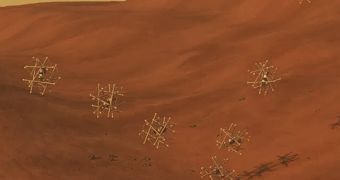Engineers at the NASA Ames Research Center (ARC), in Moffett Field, California, are proposing a new robotic concept for future missions aimed at exploring other worlds. Their machine, called Super Ball Bot, does not feature wheels or tracks, and does not require flat surfaces to operate smoothly.
Traditionally, building rovers or landers for the Moon or Mars has proven to be extremely difficult, primarily because of the demands landing on other worlds pose. For instance, engineers need to conduct a carefully-orchestrated dance, where they use parachutes, airbags and retrorockets to land an item safely.
One good is example is the Sky Crane system used for landing the 1-ton NASA Mars Science Laboratory (MSL) rover Curiosity on Mars more than a year ago. The larger the spacecraft being deployed, the heavier and more complex the associated landing system. SBB could do away with this.
The device is being developed in a way that will enable it to land without much fuss, and navigate steep terrain and sand traps without any problems. The ARC team responsible for developing the Super Ball Bot is led by engineers Vytas SunSpiral and Adrian Agogino, IEEE Spectrum reports.
Their premise for developing the machine was to create a platform with a deformable, highly-flexible exoskeleton, on which science instruments could be embedded. The SBB, currently in its prototype stage, has a relatively-spherical structure that was built according to a concept called tensegrity.
This enables the robot to absorb much of the shock of a prospective landing within its own structure, meaning less cumbersome landing equipment will be needed. It can roll around the surface of the Moon, Mars, or the Saturnine moon Titan without wheels, by simply making alterations to its shape.
The concept of tensegrity was first developed in the art world, and is usually applied to structures featuring rigid components, such as hollow tubes, which are tied to one another via flexible, elastic materials. The word itself is a combination of the terms tensional and integrity.
SunSpiral says that the main advantage of this design is that it features no single breaking point. This means that the strength of an impact is dispersed throughout the structure, and absorbed at multiple points, instead of just one.
“With a tensegrity structure, the entire structure shares the burden of reducing that stress, which is what you see in human bodies,” the ARC engineer reports. The main issue is that controlling the SBB is very difficult. The team is now working on developing innovative new ways of exerting control over the robot.
If and when the issues plaguing this design are fixed, Titan could receive an entire armada of them. SBB could work in sync to deliver massive volumes of data on what is most likely the solar system's most interesting moon.

 14 DAY TRIAL //
14 DAY TRIAL //